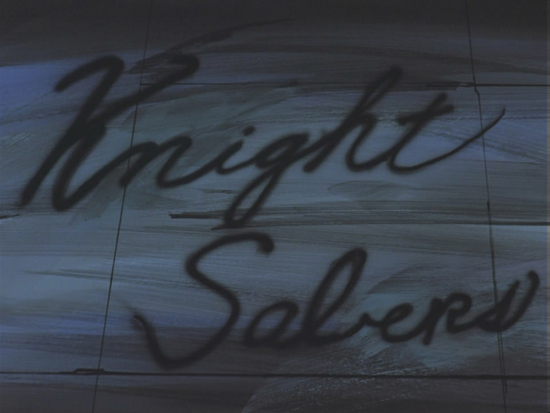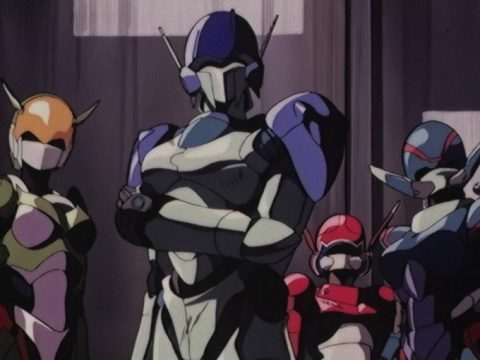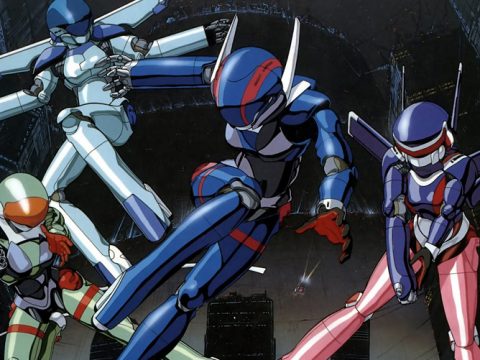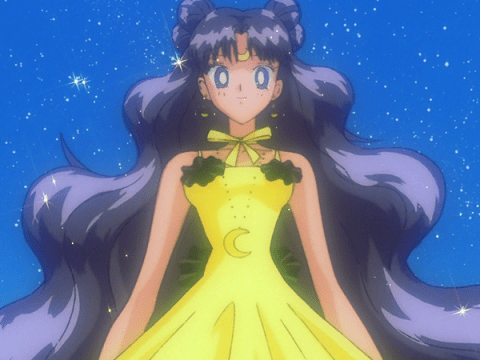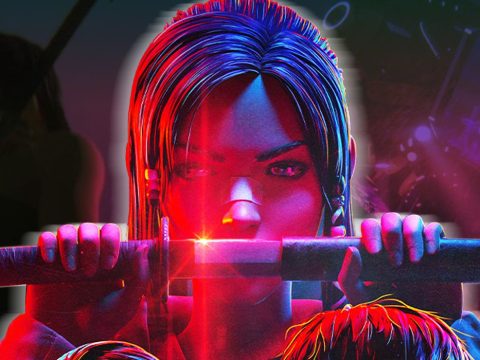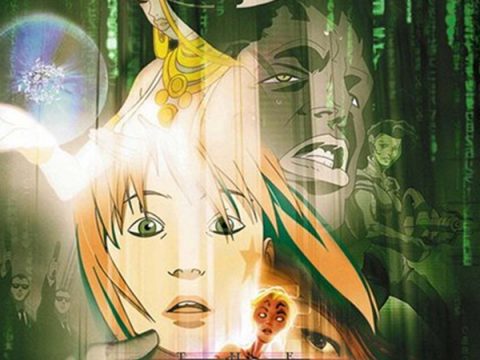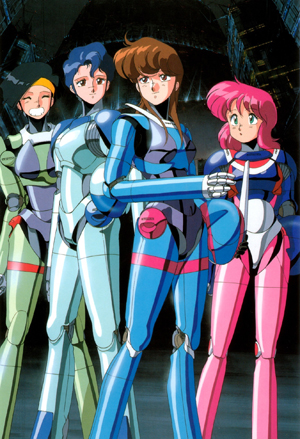 Hey, remember back when they used to release anime and the Japanese would include professionally made AMVs of their own stuff, such that when the show got released in the US, companies would just use the AMV as the trailer to sell the show? And then they’d sell those AMVs separately? You know, stuff like this? Yeah, neither do I, because that wasn’t exactly a common practice and it didn’t catch on. But little about Bubblegum Crisis was “common practice,” and that’s what makes it so fascinating to look at nearly 25 years later.
Hey, remember back when they used to release anime and the Japanese would include professionally made AMVs of their own stuff, such that when the show got released in the US, companies would just use the AMV as the trailer to sell the show? And then they’d sell those AMVs separately? You know, stuff like this? Yeah, neither do I, because that wasn’t exactly a common practice and it didn’t catch on. But little about Bubblegum Crisis was “common practice,” and that’s what makes it so fascinating to look at nearly 25 years later.
In the early 1990s, during the birth of the World Wide Web which today encapsulates what is commonly referred to as “the Internet,” Bubblegum Crisis was one of the single most popular anime titles in America. The centerpiece of one-time US anime industry leader AnimEigo’s catalog, back then it was to them what Dragon Ball Z is to FUNimation today, and while it wasn’t the first anime I ever saw, the very first thing I did upon finding a local store that rented out anime tapes was get all 8 volumes of BGC and watch through it all in a weekend. This cool-looking thing that I’d seen only glimpses of via videogame importer advertisements in the backs of print magazines was, after all, what the anime fans on Usenet were talking about the most often.
It did not disappoint. Bubblegum Crisis was—and remains—everything that a 12-year-old geek boy (or someone with the mindset of one!) could ask for out of their cartoon entertainment: robots, girl-powered armor outfitted with railguns, blood, cops getting dismembered, constantly exploding helicopters, laser beam-firing satellites, and even some brief female nudity for good measure. Despite being marketed as “the Japanese animated cyberpunk classic” it’s perhaps not quite cyberpunk seeing as how society is merely on the verge of collapse instead of already demolished, but whatever. The tagline stuck because of the visual cues lifted wholesale from Blade Runner… as I’d learned on the Internet! In an era before DVDs and streaming video existed, it would be many years until I could see Blade Runner and Streets of Fire, the two American movies that primarily inspired BGC.
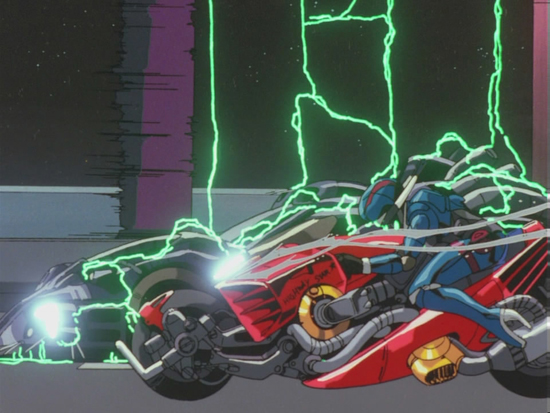
Unbeknownst to mc chris, the rather counterintuitive name “Bubblegum Crisis” ostensibly refers to a situation stretched to its limit and about to burst the way a gum bubble is when you put too much air into it, though this is never stated at any point within the anime itself. Oops! There have been a variety of spinoffs, but the original Bubblegum Crisis consists of 8 direct-to-video “OVA” installments released between 1987 and 1991. The series is set within a… “futurescape” (ahem) known as MegaTokyo—yes, this is where that webcomic got its name from—in which a mega-corporation named Genom directly controls much of government and industry alike. Genom specializes in the production of “Boomers,” androids designed primarily for construction and military use. As is the case in any story in which anyone has ever invented such automatons, Boomers have this annoying habit of gaining sentience and/or going on murderous berserker rampages against their human masters. (Why so many of these robots designed for construction happen to come equipped with mouth/chest lasers is presumably “because Genom is evil like that.”)

This happens with enough regularity that a special heavily armored police unit known as the AD Police exists solely to combat rogue Boomers, but despite this the AD Police are almost completely ineffectual at performing their stated task. The result is messily catastrophic death for pretty much every helmeted AD Police officer there is, ESPECIALLY the ones piloting those fold-out helicopters. Only “man’s man” Leon McNichol (first seen eating a parfait, which is decidedly NOT befitting of a Japanese “man’s man”), his flagrantly homosexual partner Daley Wong, and their police chief who is the same stereotypical chief of police seen in every 70s-80s cop show ever made seem capable of surviving beyond one episode. I assume it’s because they don’t wear facemasks.
The only ones who can stand up to those amoral Genom fat cats and their kill-crazy robot gorillas are the Knight Sabers, four women equipped with advanced powered armor “hardsuits” and transforming motorcycles. And yes: as is probably the case for every cartoon featuring a motorcycle that transforms into a robot, Shinji Aramaki worked on this one! You know the Knight Sabers are women because the hardsuits all have high heels and boobies molded into the armor, much to the delight of male otaku and the ire of comicbook bloggers everywhere. Let it be known that series character designer and living embodiment of the otaku stereotype Kenichi Sonoda (Gunsmith Cats) likes guns, cars, and girls to a degree that would give Ghost in the Shell author Masamune Shirow a run for his money, and so he cares not for your impotent cries for logic and practicality of attire!
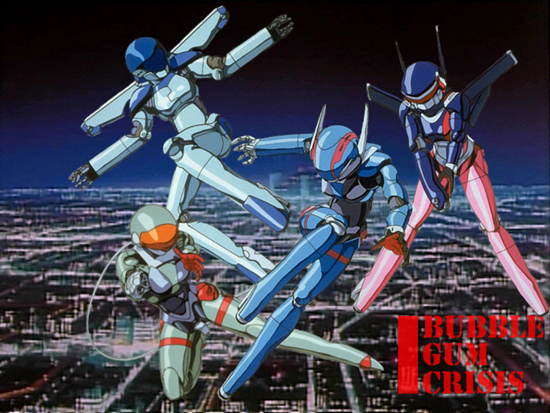
Such disdain for common sense logic is part of the modern-day charm of Bubblegum Crisis. At the time I thought nothing of it, but the Knight Sabers don’t seem especially fitting choices for a band of anti-corporate vigilante soldiers of fortune. The leader, Sylia Stingray, is a genius scientist who doubles as a lingerie store owner, the profits of which are presumably rich enough to fund her single-handedly designing and manufacturing an arsenal of the most high-tech weapons in the world in her quest to punish Genom for murdering her Professor Nambu-esque father, the original designer of the Boomers. We are told that the Knight Sabers get most of their money through their work as mercenaries, but seeing as how they rarely seem to actually get PAID I’m guessing they’re actually taking the fight to the mega-corporations one sold pair of panties at a time. Sylia’s suit may be the plainest-looking, but in terms of utility she’s the one who’s got dual swords, dual cannons, and is capable of flight. Therefore, Sylia is the best!
 Nene Romanova is a pink-haired IT clerk for the AD Police who eats too much cake to be able to fit into her hardsuit and spends most combat situations running away, being clumsy, and—as Dave Riley is quick to note—getting thrown into pipes because her suit foregoes most weaponry in favor of surveillance and hacking equipment. Clearly Nene was moé before the word “moé” was all the rage. Why, in one episode, she wears a maid outfit and everything! Linna Yamazaki is a dance aerobics instructor, an occupation that at least involves being physically fit albeit not necessarily giving one the tools to blow off robot heads using a close-range series of fist explosives known as the Knuckle Bomber. But between her fists and the monofilament ribbon whips mounted on her head, she manages just fine. Finally, there’s Priscilla “Priss” Asagiri, who gets pretty much all of the screen time on account that the production of this anime came about as a way to promote the musical career of her voice actress, Kinuko Oomori. It was thusly the only anime voice acting role Oomori ever had, which in its own way makes the character that much more unique. A biker chick and small-time nightclub singer with her band “Priss and the Replicants”—on stage she even dresses herself up to resemble Daryl Hannah’s “Pris” character—Priss’s moods alternate between “angry” and “vengeful” as she sustains and dishes out more punishment than the rest of the cast combined courtesy of rocket-powered kicks and a palm-mounted railgun/flechette cannon.
Nene Romanova is a pink-haired IT clerk for the AD Police who eats too much cake to be able to fit into her hardsuit and spends most combat situations running away, being clumsy, and—as Dave Riley is quick to note—getting thrown into pipes because her suit foregoes most weaponry in favor of surveillance and hacking equipment. Clearly Nene was moé before the word “moé” was all the rage. Why, in one episode, she wears a maid outfit and everything! Linna Yamazaki is a dance aerobics instructor, an occupation that at least involves being physically fit albeit not necessarily giving one the tools to blow off robot heads using a close-range series of fist explosives known as the Knuckle Bomber. But between her fists and the monofilament ribbon whips mounted on her head, she manages just fine. Finally, there’s Priscilla “Priss” Asagiri, who gets pretty much all of the screen time on account that the production of this anime came about as a way to promote the musical career of her voice actress, Kinuko Oomori. It was thusly the only anime voice acting role Oomori ever had, which in its own way makes the character that much more unique. A biker chick and small-time nightclub singer with her band “Priss and the Replicants”—on stage she even dresses herself up to resemble Daryl Hannah’s “Pris” character—Priss’s moods alternate between “angry” and “vengeful” as she sustains and dishes out more punishment than the rest of the cast combined courtesy of rocket-powered kicks and a palm-mounted railgun/flechette cannon.
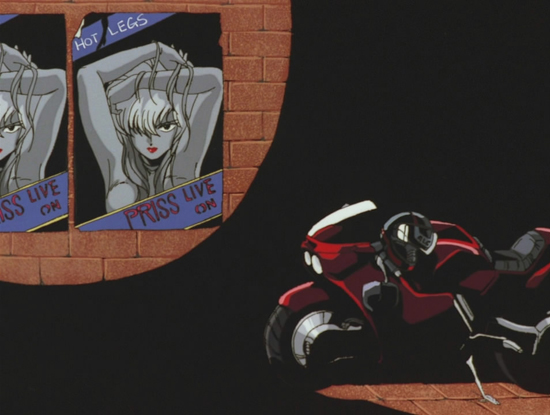
The direct-to-video nature of Bubblegum Crisis meant it wasn’t really made like how modern anime is. The episodes aren’t of uniform length, and the series has no set opening or ending theme song with set BGM tracks used throughout. Rather, each episode has its own unique set of vocals and music. Having roughly one to three unique vocal songs per episode is a feat that is generally unmatched, even in other series that place heavy emphasis on music. A regrettably more replicable feat was that the story was effectively made up on the fly from episode to episode, without much regard for overarching story plans. The series just sort of abruptly ends with nothing permanently resolved and no characters particularly fleshed-out; as the story goes, the original plan was to have 13 episodes but legal disputes resulted in 8 being the finale. A sequel series, Bubblegum Crash, was hurriedly made, and it shows. Crash wasn’t nearly as entertaining as Crisis and didn’t quite fit in with it all that well anyway for a variety of reasons. A prequel OVA entitled AD Police Files was also made and, even though it is quite good, that one is substantially grittier in tone and graphic content on account that it’s about Leon’s life as a member of the AD Police before there were any Knight Sabers to save the day. How grim is that? Well, this is what the AD Police’s lives are like when the Knight Sabers ARE around to save the day.
It can be rather difficult to tell if something evokes the era in which is made if you watch it at the time it’s made. Did you watch or listen to movies or TV shows from the 2000s and think “that is SO 2000s”? I sure didn’t. So it was that at the time when I first saw it, I didn’t bat an eye at the visuals or musical stylings of Bubblegum Crisis, but as the Gaga Communications narrator notes, the series “features the latest in video techniques created especially for the Rock Generation!” From the perspective of someone in 2011 looking back? Bubblegum Crisis might just be one of the single most “1980s” anime there is.
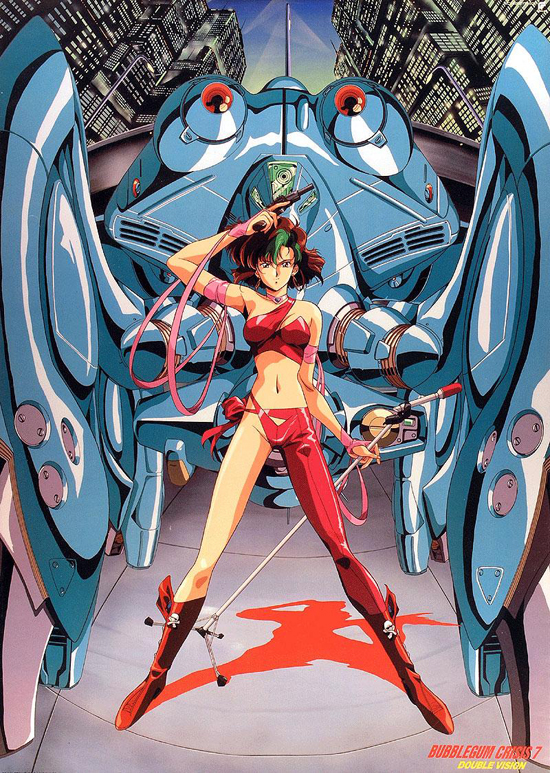
If there is a single image that better encapsulates “1980s anime” than that cover, I have not found it. As if the character designs/wardrobes, animation, and faux-cyberpunk trappings of a future world as envisioned during an era before highspeed Internet and DVD media existed weren’t already a total giveaway, the most distinguishing feature of the series will forever brand Bubblegum Crisis as a product of its time: its soundtrack, replete with electric guitars, drum machines, and [stolen…?] synthesizers aplenty. For me, songs produced in this fashion are a commonality among much of my childhood favorites, but there are quite a few people out there who consider the music of Bubblegum Crisis ear-bleedingly dreadful. Are you the type of person who winces at the thought of hearing the soundtracks to Rocky IV, Kickboxer, or The Transformers: The Motion Picture? Or, more likely, have you never SEEN those movies? Those people are the ones most likely to opine that Bubblegum Crisis 2040 is superior to the original, given 2040’s late-90s hard rock sensibilities. As I have no musical taste—okay fine, I imported the Complete Vocal Collection CDs for the original series back in the day—all I can really notice is that 2040 suffers from being a TV series at the advent of the digital revolution: mostly lackluster animation, lessened violence, recycled character designs from every other AIC-animated title of the 1990s, and a noticeably decreased rate of helicopter explosions compared to the original. With that goes most of the fun of Bubblegum Crisis! In fact, the best thing I can really say about 2040 is that thanks to it, Bubblegum Crash! is no longer the weakest link in the BGC chain.
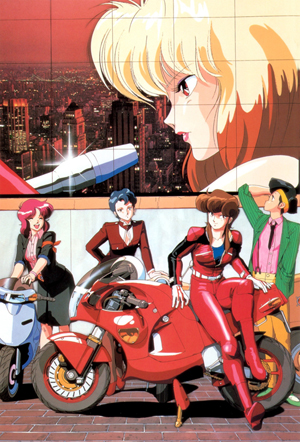
Nowadays, you can watch all of both the original 1980s Bubblegum Crisis OVAs as well as the 1990s Bubblegum Crisis 2040 TV series remake for free courtesy of sites like FUNimation.com and Hulu.com, so judge for yourselves. There’s just one catch: while 2040 is available streaming in the original Japanese, the original BGC is available dub-only. This is quite regrettable as the Bubblegum Crisis dub is NOTORIOUSLY sub-par; the type of thing frequently pointed to back in the old “dubs vs subs” arguments that used to be REALLY heated back in the days when you were forced to buy one or the other. Thanks to that dub, I picked up on the fact that the ability to convincingly voice the act of crying often separates bad dubs from the not-so-bad… and the Bubblegum Crisis dub has some of the WORST crying ever! The songs are all re-dubbed into English with decidedly mixed results; a practice that has all but vanished nowadays precisely because the vocal ranges of several Japanese songs can sound downright strange when appropriated into the English language. What’s more, they must not have been able to get the original vocal song tracks because all the instrumental melodies for those dubbed songs are approximately reconstructed sound-alikes, cover-band style. So unless you saw the dub back when you were a kid and have some bizarre nostalgia for it, you REALLY don’t want to hear Bubblegum Crisis for the first time in English. As is the case with virtually all Animeigo titles at this point, the lowest price to buy Bubblegum Crisis on DVD is directly from the Animeigo.com website. There was a Japanese release of the series on Blu-Ray afew years ago that will play on US players, but between the added costs, lack of subtitles, and the fact that direct-to-video animation from this era was never intended to be viewed in high-definition, that route is definitely “for fans only.”
The biggest fan/apologist of Bubblegum Crisis 2040 I’ve ever met—that’s you, DAVE RILEY—said in the October 2011 issue of Otaku USA that “2040 is not a revolution. It’s hardly even an evolution. It’s an above average show that’s trying its best, gosh darnit, and can’t we all just give it a shot?” And if you caught me on a really good day, I might just agree with that statement as being true, both for when 2040 came out as well as today. But on MOST days, I’d disavow the existence of Bubblegum Crisis 2040, because for the time it came out the original Bubblegum Crisis WAS seen as a revolution, an evolution, and a much more than above average series. That said, it almost certainly is absolutely none of those things today in the eyes of people who are not me. Is it better to be consistently “all right” or transiently stupendous? That’s difficult to decide, but as far as I’m concerned there’s always going to be a hurricane tonight.
